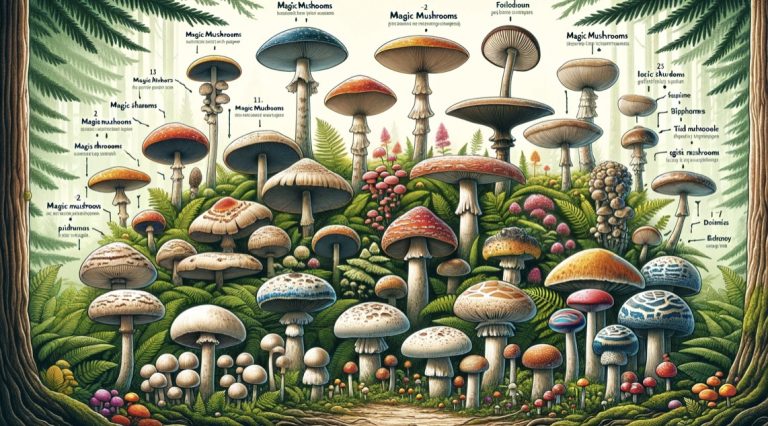Magic mushrooms, also known as psilocybin mushrooms, have intrigued and intrigued for centuries. With the growing interest in their potential therapeutic benefits and the shifting legal landscape in 2024, more people seek to understand and identify these fascinating fungi. In this guide, we’ll explore the key characteristics of magic mushrooms and offer tips to help you identify them safely.
Story Stages
Understanding Magic Mushrooms
Before we dive into identification, it’s crucial to understand what magic mushrooms are. These are a group of fungi that contain psilocybin, a naturally occurring psychedelic compound. When ingested, psilocybin is converted into psilocin, which is responsible for the mushrooms’ psychoactive effects.
Types of Magic Mushrooms
There are over 180 species of magic mushrooms, but the most common and well-known is Psilocybe cubensis. Other notable species include Psilocybe semilanceata (liberty cap), Psilocybe cyanescens (wavy caps), and Psilocybe azurescens. Each species has unique characteristics, but common features help in their identification.
Key Identification Features
- Cap Shape and Color: Magic mushroom caps vary from conical to bell-shaped and flatten with age. The color can range from light brown to golden, often becoming paler towards the edges.
- Gill Structure: Under the cap, look for closely spaced gills. They usually start out as light-colored and darken as the mushroom matures due to the maturing of spores.
- Spore Print: A crucial identification tool is the spore print, which should be a dark purplish brown to black for most psilocybin-containing mushrooms. To take a spore print, remove the stem, place the cap gill-side down on white paper, and leave it for a few hours.
- Stem Characteristics: The stems are typically slender and range from white to pale yellow. Bruising is also an important indicator; psilocybin-containing mushrooms often bruise blue when handled or damaged.
- Habitat and Season: Most magic mushrooms grow in moist, nutrient-rich environments. Psilocybe cubensis, for example, is often found in dung-rich grasslands, while others prefer wooded areas.
Safety and Legal Considerations
While identifying magic mushrooms can be fascinating, it’s crucial to approach this with caution and respect for legal boundaries. As of 2024, the legality of possessing, cultivating, and using psilocybin mushrooms varies significantly across different regions.
Always check your local laws before engaging with these mushrooms.
Moreover, misidentification can be dangerous. Many mushrooms, including toxic and potentially lethal varieties, can look similar to psilocybin mushrooms. When in doubt, consult an expert mycologist or refrain from ingesting any wild mushrooms.
Tips for Accurate Identification
- Use Multiple Sources: Don’t rely on a single characteristic or source for identification. Cross-reference with reputable field guides and online resources.
- Join Local Mycology Groups: Engaging with local mycology clubs or online forums can provide valuable insights and support from experienced mushroom foragers.
- Take a Workshop or Course: As interest in mycology grows, more workshops and courses are available. These can provide hands-on experience and guidance from experts.
- Document Your Findings: Take clear photos of the mushrooms, including close-ups of the cap, gills, stem, and any bruising. Note the habitat where you found them.
- Start with Common Species: Beginners should focus on learning to identify the most common species of magic mushrooms, like Psilocybe cubensis, before moving on to less common varieties.
The Ethical Forager
Responsible and ethical foraging is key. This means not over-harvesting, respecting private property, and being mindful of the ecological impact of removing mushrooms from their natural habitat. Remember, mushrooms play a crucial role in their ecosystems.
The Future of Magic Mushrooms
The landscape of magic mushrooms is evolving, with increasing research into their therapeutic potentials, such as treating depression, anxiety, and PTSD. This growing body of evidence shapes the conversation around their legal status and safe use.
Conclusion
Identifying magic mushrooms is a skill that combines science, patience, and a deep respect for nature. Whether you’re a curious novice or an experienced forager, understanding these fascinating fungi is a rewarding journey.
However, always prioritize safety, legality, and ethical considerations. With the right approach, the world of magic mushrooms offers a unique blend of mystery, science, and potential healing. Remember, while this guide provides a starting point, there is no substitute for hands-on learning and consultation with experts. Happy foraging, and stay safe!
